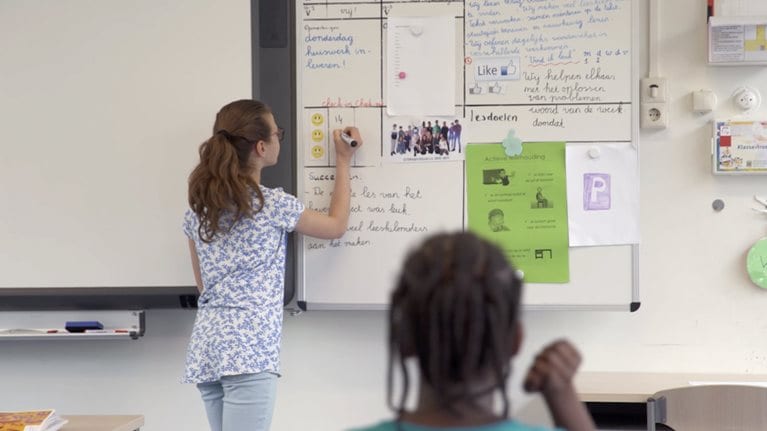The Netherlands has historically been proud of its education system. When the first international assessments were launched near the turn of the century, the Netherlands was one of the top countries globally, placing fourth according to the 2003 Programme for International Student Assessment (PISA).1 But by 2012, the Netherlands had dropped to tenth place, and the country’s educators felt a creeping sense of inertia.2 Tests and curricula were increasingly standardized, and teachers began to feel like they were managing an educational production line rather than pushing the boundaries of curiosity and creativity. Multiple government-led transformation efforts resulted in reform fatigue.
The leerKRACHT foundation, launched in 2012 by Jaap Versfelt, tackled these challenges by working with school systems from the bottom up to create a culture of continuous improvement focused on the quality of teaching. Over the past eight years, the program has reached 900 schools, and teachers and principals are invigorated by its impact on student outcomes and school culture.
In this interview, Versfelt provides insight into how he’s led the transformation of schools across the country by putting teachers at the center of the process, encouraging communication among teachers and schools, and practicing what he preaches—that is, continuously improving leerKRACHT alongside the country’s schools.
McKinsey: What was the education system in the Netherlands like before leerKRACHT, and where did you see the biggest opportunities?
Jaap Versfelt: The education system was good, as the PISA results show, but it was not improving. At the same time, there were signals—maybe not on the surface but underneath—that the situation was deteriorating. Everyone was working harder to maintain performance. But the focus was mostly on accountability, standards, and performance management. Instead of strengthening the teachers, this focus, which required them to use scripts to teach, was degrading teachers into robots. All of this made the teaching profession less popular, which wasn’t a good sign for the future.
Schools in the Netherlands are highly independent institutions: there is no mediating layer between the schools and the Ministry of Education. They can decide for themselves how to spend their budgets and whom to work with. While this could have been a challenge for centrally driven reform initiatives, it gave us an opportunity to intercede at the grassroots level to change the system.
McKinsey: How did you determine the core elements of your program and begin to implement it in schools?
Jaap Versfelt: In the beginning, we selected 16 schools that we could work with to design and implement a continuous improvement culture. We did not do this alone. We leaned on help from the teaching unions, which provided people to act as coaches in the schools, and on McKinsey's seminal reports on transforming school systems in 2007 and 2010. These reports stressed the primary importance of teachers and teaching in school transformations and the power of peer learning in moving from a good system to a great one. We combined these insights with our continuous-improvement operational expertise, which we learned from our work with companies.
With the teachers and leaders from our pilot schools, we codeveloped four key interventions: joint lesson planning, colleague lesson observations and feedback, whiteboard sessions (weekly or daily huddles around a whiteboard to set goals and review actions), and student involvement in the process, which echoed the corporate approach of putting customers at the center of conversations.
We started implementing them almost immediately, recruiting the 16 schools in May. In September we were live. We used a “field and forum” change-management approach—working within each individual school as well as creating opportunities for all the schools to talk with each other for encouragement and learning.
We realized early on that it was going to be difficult to obtain central funding, so schools would need to self-fund these initiatives—often out of their professional-development budgets. There was no budget for consultants, professional HR, operational-excellence departments, or training modules. We therefore used a “train the trainer” approach, which kept costs low and ensured that the schools owned the process.
McKinsey: How was the vision of reform, progress, and impact communicated to different groups—including participants, policy makers, and wider stakeholders?
Jaap Versfelt: We started off at the grassroots level, talking to teachers and friends; our colleagues would go back to their own schools and invite them to codesign the programs with us. It was a collaborative process. In the first years, I also spent a lot of time talking with stakeholders in the Dutch school system—ministers of education, union leaders, education aldermen, senior politicians, teacher representatives, professional bodies, and so forth. With the unions it was a matter of showing how we were putting teachers at the center, giving them joint ownership of the process. I also pledged to give up my career at McKinsey and to volunteer full time at leerKRACHT, and that gave others the confidence to also put real time into the foundation.
Within schools, our initial contact was with leadership, and then subgroups of teachers would engage. We gained the trust of teachers because we were a grassroots organization. Some of the teachers in our initial pilot schools drew a series of concentric circles to represent the school system. In the middle are the teachers and school leaders, around them are the school boards and school inspectorate, beyond that is the Ministry, and even further out are the education consultants who advise the Ministry. What we managed to do was go from the outer circle right to the middle, being viewed by the teachers as “one of them.”
Leerkracht means “teaching force” in Dutch, and we at the foundation have always had extremely high expectations of the teachers but also kept them at the middle of everything we do, refining the approach with their feedback. Early on we did not think of engaging with students, but the teachers showed us we were also creating an active role for students to drive lesson improvement. After a few years, some school participants became great advocates for the program, and they went out to speak to other schools, spreading the message and telling their stories. Teachers felt that the program really changed their professional life. They were suddenly talking with and learning from each other, and there was more esprit de corps.

How artificial intelligence will impact K-12 teachers
McKinsey: How did you build the organization’s leadership and capability?
Jaap Versfelt: At McKinsey, I led the Service Operations Practice worldwide—which gave me experience in leading complex transformations and creating large scale change. I also had a nucleus of people around me with the time, resources, and experience to help. That support helped to build the central organization, but building up a cadre of leerKRACHT expert coaches was the most critical enabler in helping teachers and driving change.
We have two types of coaches in our program: school-level coaches—teachers who make themselves available a half-day a week to implement the program in their own school—and leerKRACHT expert coaches who “coach the coach.” That is, they teach the school team how to tailor and implement the leerKRACHT method of peer-led continuous improvement in their school.
Our expert coaches are typically extremely experienced and come from three complementary backgrounds. They are previous school leaders, master teachers, or people with a background in lean management or agile scrum—meaning they understand continuous improvement. We like to hire coaches who are older; the average age of our people is 50 to 60. Collectively they have the gravitas and experience to help their schools. Yet we pay them teacher salaries. They could obviously earn more, but they believe in the purpose of leerKRACHT and want to be part of a bigger movement to change our school system.
McKinsey: Given the large-scale and long-term nature of the effort, how was momentum sustained as the organization scaled?
Jaap Versfelt: We wanted to stay relatively small to preserve our organizational culture. We are currently at about 40 people and work with a few hundred schools each year. Our way of working with individual schools is to engage intensively in the first year, more lightly in the second year, and move to check-ins in the third year. This structure allows us to constantly move on to new schools. Cumulatively we have reached about 11 percent of all schools in the Netherlands.
We also work hard to maintain quality as we grow. Our expert coaches are key to helping us do this, but we also codified our method in an online academy. This enables people who do not have experience in creating a culture of continuous improvement to implement the program, while also providing flexibility for schools to tailor the program to their needs.
We are, of course, applying the mantra of continuous improvement to our own organization as well. We are constantly learning. Every week I go to a school, sometimes two or three schools, to see the method and people in action and learn how we can improve. The success of leerKRACHT comes from a little bit of effort in the beginning to get it started and then a lot of effort to improve the impact over time. This is the opposite of so many education-reform programs, which are built around investing a lot of time and money at the beginning but then contributing only money to subsidize the scaling of the reforms.
We are gradually building and creating more impact and, of course, honing our method over time to make it easier to use. Also, as teachers rotate through schools, the culture spreads. We are even starting to see some uptake in teaching colleges, allowing teachers to pick up some of the principles before they start in the workplace.
McKinsey: Overall, how would you describe the impact of this transformation effort? What evidence do you have of improving student outcomes?
Jaap Versfelt: The only way we can keep going and growing is by improving our impact. We are dead in the water without impact. We therefore asked researchers from Utrecht University to analyze the program on four levels: Are we executing effectively? Have we changed the culture? Has teaching quality improved? And are those things leading to better learning outcomes?
The study is still in progress, but initial results confirm that we can create a continuous-improvement culture across our cohort within one year. Eighty to 90 percent of participating school leaders and teachers have great confidence that our methods lead to better teaching quality. Most excitingly, initial results in primary schools suggest an 8 percent improvement in learning outcomes two years after the start of the program.
McKinsey: While the leerKRACHT schools appear to be thriving, the performance of the Netherlands as a whole on international assessments continues to disappoint. What are the plans for continued education reform across the country?
Jaap Versfelt: The first part is to continue expanding our current model. I think in due course we can bring our program to 1,500 schools. At that point, 20 percent of our teaching force will be familiar with and enthusiastic about the method. We are hoping thereafter that the “virus” will be planted and that teachers won’t want to stop. That it cannot be put back under the lid.
What we don’t want is for the government or anyone else to mandate the leerKRACHT approach. That would defeat the purpose. Instead, they can help by telling the story and providing a very small amount of money to participating schools to help pay for their coaches and teachers.
We would also like to see more progress at the teacher-training level—making the framework part of the basic curriculum and setting a consistent standard for how we educate.
Our ultimate ambition is to be so successful and integrated into the system that we make ourselves redundant. Over time, the teachers who have been part of leerKRACHT will become school leaders, and the school leaders will become school board leaders, and the school board leaders will start populating the Ministry of Education. Perhaps within 20 years the transformation will be complete.


